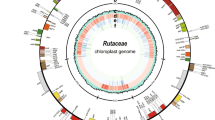Abstract
Several examples of the introduction of a gene from one gene complex into another (introgression) are found when chloroplast RP gene clusters are compared to those in Escherichia coli or cyanobacteria. Here we describe the transcript pattern of one such cluster from maize (Zea mays) that includes the genes for 4 subunits of the thylakoid ATP synthase (atpI, H, F, A) and the rps2 gene. Twelve transcript species covering the size range from 7 000 to 800 nt were identified in RNA isolated from dark-grown and greening maize seedlings, and several of them were characterized by reverse transcription analysis. A major species of 6 200 nt, with its 5′ end at 181 nt upstream of the initiating ATG of rps2, contained the transcripts of all the 5 genes. Two further sets of transcripts having their 5′ ends ca. 120 and 50 nt upstream of the initiation codons of the atpI and atpH genes were also identified. Thus, this plastid gene cluster in maize is functionally organized as an operon with additional regulatory features to allow for increased accumulation of mRNAs for the thylakoid components.
Similar content being viewed by others
References
Stahl D, Rodermel SR, Subramanian AR, Bogorad L: Nucleotide sequence of a 3.46 kb region of maize chloroplast DNA containing the gene cluster rpoC2-rpS2-atpI-atpH. Nucl Acids Res 18: 3073–3074 (1990).
Bogorad L, Vasil IK (eds): The Photosynthetic Apparatus: Molecular Biology and Operation. Academic Press, New York (1991).
An G, Bendiak DS, Mamelak LA, Friesen JD: Organization and nucleotide sequence of a new ribosomal operon in Escherichia coli containing the genes for ribosomal protein S2 and elongation factor Ts. Nucl Acids Res 9: 4163–4172 (1981).
Ichikawa S, Kaji A: Molecular cloning and expression of ribosome release factor. J Biol Chem 264: 20 054–20 059 (1989).
Walker JE, Gray NJ, Saraste M, Eberle AN: DNA sequence around the Escherichia coli unc operon. Biochem J 224: 799–815 (1984).
Bachmann BJ: Linkage map of Escherichia coli K-12, edition 8. Microbiol Rev 54: 130–197 (1990).
Sanangelantoni AM, Calogero RC, Buttarelli FR, Gualerzi CO, Tiboni O: Organization and nucleotide sequence of the genes for ribosomal protein S2 and elongation factor Ts in Spirulina platensis. FEMS Microbiol Lett 66: 141–146 (1990).
Cozens AL, Walker JE: The organization and sequence of the genes for ATP synthase subunits in the cyanobacterium Synechococcus 6301. J Mol Biol 194: 359–383 (1987).
Chirgwin JM, Przybyla AE, MacDonald RJ, Rutter WJ: Isolation of biologically active ribonucleic acid from sources enriched in ribonuclease. Biochemistry 18: 5 294–5 299 (1979).
Maniatis T, Fritsch EF, Sambrook J: Molecular Cloning: A Laboratory Manual. Cold Spring Harbor Laboratory Press, Cold Spring Harbor, NY (1982).
Sanger F, Nicklen S, Coulson AR: DNA sequencing with chain-terminating inhibitors. Proc Natl Acad Sci USA 74: 5 463–5 467 (1977).
Rodermel SR, Bogorad L: Molecular evolutions and nucleotide sequences of the maize plastid genes for the α subunit of CF1 (atpA) and the proteolipid subunit of CF0 (atpH). Genetics 116: 127–139 (1987).
Larrinua IM, Muskavitch KMT, Gubbins EJ, Bogorad L: A detailed restriction map of the Zea mays plastid genome. Plant Mol Biol 2: 129–140 (1983).
Sugiura M: The chloroplast chromosomes in land plants. Annu Rev Cell Biol 16: 293–301 (1989).
Rodermel S, Bogorad L: Maize plastid photogenes: mapping and photoregulation of transcript levels during light-induced development. J Cell Biol 100: 463–476 (1985).
Hudson GS, Mason JG, Holton TA, Koller B, Cox GB, Whitfeld PR, Bottomley W: A gene cluster in the spinach and pea chloroplast genome encoding one CF1 and three CF0 subunits of the H±-ATP synthase complex and the ribosomal protein S2. J Mol Biol 196: 283–298 (1987).
Rapp JC, Baumgartner BJ, Mullet J: Quantitative analysis of transcription and RNA levels of 15 barley chloroplast genes. J Biol Chem 267: 21 404–21 411 (1992).
Haley J, Bogorad L: Alternative promoters are used for genes within maize chloroplast polycistronic transcription units. Plant Cell 2: 232–333 (1990).
Ruf M, Kössel H: Structure and expression of the gene coding for the α subunit of DNA-dependent RNA polymerase from the chloroplast genome of Zea mays. Nucl Acids Res 16: 5 741–5 754 (1988).
Weglöhner W, Subramanian AR: Nucleotide sequence of maize chloroplast rp132: completing the apparent set of plastid ribosomal protein genes and their tentative operon organization. Plant Mol Biol, in press (1993).
Author information
Authors and Affiliations
Rights and permissions
About this article
Cite this article
Stahl, D.J., Rodermel, S.R., Bogorad, L. et al. Co-transcription pattern of an introgressed operon in the maize chloroplast genome comprising four ATP synthase subunit genes and the ribosomal rps2 . Plant Mol Biol 21, 1069–1076 (1993). https://doi.org/10.1007/BF00023603
Received:
Accepted:
Issue Date:
DOI: https://doi.org/10.1007/BF00023603




